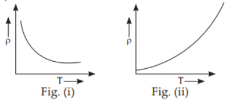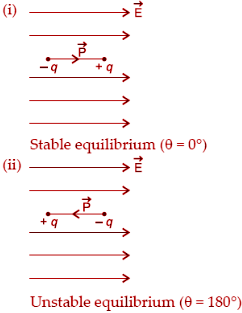Table of Contents

Ans. (b) material A is germanium and material B is copper
Explanation:
For semiconductors, there are very few free electrons. The conductor’s resistance decreases as a result of an increase in the number of free electrons that can act as carriers as a result of rising temperature [Fig. (i)]
For a conductor, when temperature rises, more free electrons become available. As a result, more of them begin to oppose one another’s motion, increasing the conductor’s resistance [Fig. (ii)]
We know germanium is a semiconductor while copper is a conductor.
So, fig. (i) is a semiconductor while fig. (ii) is a conductor.
Hence, option (b) is correct.
Ans. (d) mass of B increases
Explanation: Negative charge means excess of electrons which increases the mass of sphere B, whereas positive charge on sphere A is given by removal of electrons.
Explanation:


Explanation:
(i) Work done :
| Chapter No. | Chapter Name |
|---|---|
| Chapter 1 | Electric Charges and Fields |
| Chapter 2 | Electrostatic Potential and Capacitance |
| Chapter 3 | Current Electricity |
| Chapter 4 | Moving Charges and Magnetism |
| Chapter 5 | Magnetism and Matter |
| Chapter 6 | Electromagnetic Induction |
| Chapter 7 | Alternating current |
| Chapter 8 | Electromagnetic Waves |
| Chapter 9 | Ray Optics and Optical Instruments |
| Chapter 10 | Wave Optics |
| Chapter 11 | Dual Nature of Radiation and Matter |
| Chapter 12 | Atoms |
| Chapter 13 | Nuclei |
| Chapter 14 | Semiconductor Electronics: Materials, Devices and Simple Circuits |
| Chapter Wise Important Questions for CBSE Board Class 12 Physics |
|---|
| Electric Charges and Fields |
| Electrostatic Potential and Capacitance |
| Current Electricity |
| Moving Charges and Magnetism |
| Magnetism and Matter |
| Electromagnetic Induction |
| Alternating current |
| Electromagnetic Waves |
| Ray Optics and Optical Instruments |
| Wave Optics |
| Dual Nature of Radiation and Matter |
| Atoms |
| Nuclei |
| Semiconductor Electronics: Materials, Devices and Simple Circuits |
CBSE Important Questions Class 10
ICSE Important Questions Class 10
CBSE Important Questions Class 10
ICSE Important Questions Class 10